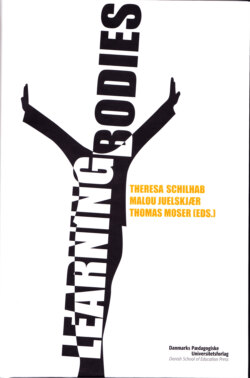Читать книгу Learning Bodies - Группа авторов - Страница 9
На сайте Литреса книга снята с продажи.
The educated body (part three)
ОглавлениеCorporeality, exercise, mental health and mental disorders by Egil Martinsen & Thomas Moser provides an overview of the increasing scientific documentation of correlative and causal relations between a variety of aspects of corporeality, mental health and mental disorders explanations of these relations. Several theories that try to explain how corporeal processes may affect different aspects of mental health (and disorders) are discussed and vague and contradictory findings as well as limitations in the existing body of knowledge are addressed. Today there still is no ‘grand theory’ that can give a full explanation of these relations.
Cultural body learning – the social designation of code-curricula by Cathrine Hasse. In this chapter, Hasse connects discussions from the disparate fields of psychology, anthropology and philosophy while offering new theory regarding how learning influences the conceptualisation of physical place and the body as well as identities and the sense of belonging in physical space. Through empirical analysis of newcomers becoming a member of an institutionalized community (university students), Hasse develops the concept ‘cultural code-curriculum’, which is learned pre-discursively through bodily interaction and reaction to bodily presence and actions. Learning the code-curriculum, Hasse argues, can influence who becomes a physicist and who does not.
Approaches to enhance body-anchored and experience-based learning is the final contribution by Reinhard Stelter. As the first two chapters have been theoretical, this one is practical/empirical in the sense that he develops ideas for the application of body-anchored learning. The main focus is on empirical examples from physical education. Body-anchored learning is conceptualised and analysed as integrated in a cultural setting and as part of learning in a community of practice.
Embodied learning in movement by Liv Duesund, is a philosophical exploration of the relation between the body as an object and the body as a subject. Duesund bases her discussion on the field of APA (Adapted Physical Activity). As she develops a body/phenomenological approach to understand adapted physical activity, she challenges existential dimensions in the field of APA. The chapter presents a theoretical outline of possible conditions needed to avoid objectification of participants engaged in APA.
The body as narrator by Helle Rønholt. Rønholt analyses complex negotiations of bodily in- and exclusions in a social context – in a Fourth Grade PE-class. Rønholt’s empirical/analytical framework stems primarily from phenomenology, and the analysis offers perspectives on learning premises for children and teachers in an ethnic racialized space. Furthermore, by introducing the key analytical concept ‘the silent body’, Rønholt questions whether a bodily inertia in some places and cases might prevent learning.
In Movement analyses and identification of learning processes, Mia Herskind works on empirical material based on observations in two kindergarten institutions, and she presents an approach to legitimate and differentiate an interpretation of how focus on bodies and movements can qualify the understanding and interpretation of children’s learning and well-being in kindergarten. Her frame of reference is hermeneutical/phenomenological, i.e. related to research questions that concerns learning processes, not only as reflective and discursive, but also pre-reflective, corporeal and emotional.
Finally, in the chapter Body bildung – an essay about learning and corporeality Søren Kjær Jensen & Thomas Moser point out that in future corporeality and embodiment in educational settings should be reflected in a much higher degree and more differentiated than today. They claim that body and corporeality, as core components of Bildung, need to lay the foundation for an active, engaged and genuinely embodied educational practice which may support a balanced ‘being in the world’ in children.
In the closing chapter of the anthology, Post Scriptum – On ‘Learning bodies’, the editors sum up the themes of the anthology with special attention to the problems of addressing the body from a single perspective i.e. within a single scientific field. With the chapter we hope to emphasise that truly accepting and stimulating the reunion of body and learning cannot be accomplished from within a single perspective. It is our hope that at a meta-level this anthology exemplifies why.
